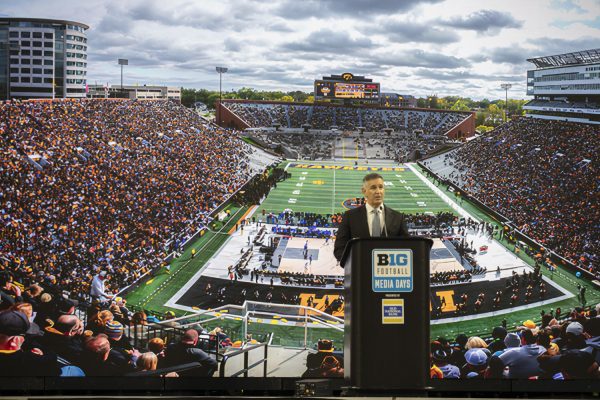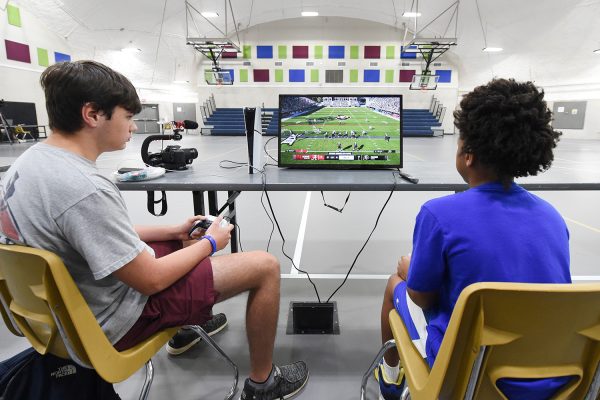Opinion | Iowa’s offensive performance against Nevada isn’t indicative of future success
The Hawkeyes could only muster 175 yards and a touchdown against the 121st-ranked pass defense in the 131-team FBS.
Iowa quarterback Spencer Petras throws the ball during a football game between Iowa and Nevada at Kinnick Stadium in Iowa City on Saturday, Sept. 17, 2022. Petras passed for 175 yards and a touchdown. The Hawkeyes defeated the Wolf Pack, 20-7.
September 18, 2022
Saturday’s Iowa-Nevada game is certainly one of the strangest I’ve seen in my three years covering the Hawkeye football team. The contest took about seven hours to play, featured three lightning delays, and ended just after 1:30 a.m.
While Iowa did end up blowing Nevada out, 27-0, the matchup didn’t lack any excitement or drama.
True freshman running back Kaleb Johnson scored one 40-yard touchdown and another 55-yard TD. Sophomore wide receiver Arland Bruce caught a 21-yard touchdown pass — the Hawkeyes first TD through the air in 2022. And wideout Nico Ragaini hauled in a 46-yard throw from quarterback Spencer Petras.
I’m sure all of that sounds like cause for optimism for Hawkeyes fans. At long last, Iowa’s offense showed a pulse.
I agree with the sentiment — to an extent. The Hawkeyes’ offense certainly did take a step in the right direction Saturday night and Sunday morning.
I’d still encourage the Hawkeye faithful to proceed with caution. I wouldn’t bank on Iowa’s offense to look that good again at any point this season.
What we saw on the field on Saturday night was an augmented look at the Hawkeyes’ offense. And I think there are a few indicators that illustrate my point.
First, I’ll state the obvious. Nevada was an inferior opponent. From top to bottom, the Wolf Pack were clearly outmatched by the Hawkeyes at almost every position.
The Wolf Pack entered Saturday’s contest with the 95th-ranked defense in the country. Their pass defense was rated 121st in the nation before Week 3.
In their first three games of the season, the Wolf Pack gave up 27 points per game. Coincidentally, that was the exact total the Hawkeyes’ hit Saturday night.
Here’s the catch, Nevada played its first three games against New Mexico State, Incarnate Word, and Texas State. I’d consider all of those teams inferior to the Hawkeyes. Yet, on average, they still managed to score the same number of points Iowa did Saturday night.
As of Week 2, both Texas State (88th) and New Mexico State (130th) rank higher than Iowa in offensive production. Incarnate Word — an FCS team — even managed to hang 55 points on the Wolf Pack.
Had Iowa’s offense not found ways to score against a horrid Wolf Pack defense this week, it really would’ve been time for the Hawkeyes to sound the alarm. But Iowa has staved the panic button off for another week.
Still, Iowa fans shouldn’t think their team has turned the corner just because they aren’t actively panicking.
The issues that plagued the Hawkeyes’ offense against the South Dakota State Jackrabbits and Iowa State Cyclones’ defenses proved pervasive during Week 3.
The Hawkeyes offensive line, which entered the week ranked ninth in the Big Ten Conference in pass protection, let up a few massive sacks Saturday. Iowa starting quarterback Spencer Petras was sacked three times, netting 23 total yards lost.
Two of Nevada’s sacks came via overload blitzes. The Wolf Pack stacked up pass rushers on one side of Iowa’s offensive line, and the Hawkeyes failed to pick up the extra defenders. On at least one, if not two, occasions, defenders hit Petras unblocked.
Nevada’s pass rush was tied for 64th in the nation before Saturday’s game, averaging two sacks per game. Iowa let up more than the Wolf Pack’s average in sacks.
Playing seven or nine yards behind the sticks because of a sack doesn’t prove costly versus a poor opponent like Nevada, but I promise it will against the rest of the teams on the Hawkeyes’ schedule.
For the most part, Iowa also failed to run block effectively. Yes, I know I mentioned Johnson’s two touchdowns. But, if you take those explosive plays away, Iowa gained just 87 yards on the ground. For those keeping score at home, that’s 2.6 yards per carry.
Through two weeks of play, Iowa’s rushing offense ranked 127th in the nation at 1.89 yards per carry. If you take out Johnson’s touchdowns, that’s about where the Hawkeyes’ landed Saturday.
Sophomore Gavin Williams was Iowa’s bell cow, accounting for 16 of their 35 rushes on the day. His long run of the game was just 12 yards. He gained 57 yards on the contest — that’s about 3.6 yards per attempt.
I will acknowledge that Williams has been dealing with a reported ankle injury for the first few games of the season. And Nevada’s run defense ranked 37th in the nation after the Wolf Pack played their first three games.
Still, Nevada’s defense earned that ranking after it beat up New Mexico State’s 112th-ranked rushing attack in Week 1.
Iowa also probably didn’t have as good of a day as it should have had in the passing game.
With their top two options at wide receiver, Nico Ragaini and Keagan Johnson, back in the lineup, the Hawkeyes racked up 175 yards and one touchdown through the air. While the numbers are significantly better than those Iowa posted in Weeks 1 and 2, they’re likely not good enough to propel the Hawkeyes to a Big Ten West title or even a bowl game, for that matter.
Appalachian State owned the 65th-best passing attack in the nation through two weeks of action with 247.5 yards per game. The Mountaineers are ranked almost directly in the middle of the 131-team FBS in passing offense. If Appalachian State’s 247.5 yards per game is considered an average or slightly above average performance, then the Hawkeyes are still missing the mark in the air.
Iowa’s best passing performance of the season to this point featured 175 yards and one touchdown. Using the Appalachian State example, Iowa is still almost 75 yards away from the national average on its best passing day of the year.
Even with their top two wideouts, Nico Ragaini and Keagan Johnson, back, the Hawkeyes couldn’t eclipse 200 yards passing. Granted, it was raining pretty hard throughout Saturday’s game and the Hawkeyes did drop some passes.
I’m still inclined to believe Iowa should score more than one touchdown and gain at least 200 yards through the air against the 121st-ranked pass defense in the FBS.
Don’t get me wrong, the return of Ragaini and Johnson is a big deal, but it’s a band-aid. You don’t put a band-aid on a bullet wound like the one Iowa’s offense has been nursing all season.
Taking out Ragaini’s 46-yard reception that probably would’ve been intercepted by a better defense, the Hawkeyes’ offense only passed for 129 yards. Petras threw at least four other balls that could’ve been picked off, as Nevada racked up four pass break-ups.
Petras almost overthrew his touchdown pass to Bruce in the first quarter too. Bruce was wide open in the end zone and he still had to sprint to get under Petras’ throw.
Johnson and Ragaini caught a combined four passes for 67 yards — though Johnson didn’t play in the second half because of the lightning delays.
“He just didn’t feel like he could get loose,” Iowa head coach Kirk Ferentz said of Johnson postgame. “Such unusual circumstances, you know?”
Iowa’s offense took some baby steps forward on Saturday. But if Incarnate Word can drop 55 on Nevada, surely Iowa should score at least 30.
Like Ferentz said, the circumstances of Saturday’s game were unusual. So, it’s hard for me to make a complete judgment of Iowa’s performance.
It’s good that the Hawkeyes showed signs of life Saturday, but I’m not going to take it as an indicator of things to come. Rather, it might be a warning about how tough Big Ten play will be on Iowa this season.















